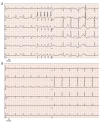Successful Resuscitation of Cardiac Arrest After Refeeding Syndrome Associated with Hiatal Hernia: A Case Report
- PMID: 35525535
- PMCID: PMC9092313
- DOI: 10.12659/AJCR.935605
Successful Resuscitation of Cardiac Arrest After Refeeding Syndrome Associated with Hiatal Hernia: A Case Report
Abstract
BACKGROUND Refeeding syndrome (RFS) is a life-threatening syndrome, which can cause sudden death. RFS has been reported frequently in young patients with anorexia without organic disease; however, there are few reports in elderly patients with organic disease. Herein, we report a case of cardiac arrest after refeeding syndrome associated with hiatal hernia. CASE REPORT We report the case of a 59-year-old woman who had a diagnosis of RFS during treatment for anorexia secondary to hiatal hernia. She was hospitalized with hypothermia, anemia, and hypovolemic shock and treated with electrolytes, hydration, and transfusion at the Emergency Department. Upper gastrointestinal endoscopy revealed hiatal hernia with severe reflux esophagitis. We initiated parenteral nutrition (8.7 kcal/kg/day). However, QTc prolongation caused pulseless ventricular tachycardia. Temporary cardiac pacing was performed to prevent recurrence. Her nutritional status steadily improved, and she was transferred to another hospital without complications. CONCLUSIONS Patients with gastrointestinal comorbidities are more likely to have inadequate food intake and to be undernourished on admission and therefore should be carefully started on nutritional therapy, considering their risk of RFS.
Conflict of interest statement
Figures



Similar articles
-
Cardiogenic shock caused by a left midventricular obstruction during refeeding in a patient with anorexia nervosa.Nutrition. 2017 Mar;35:148-150. doi: 10.1016/j.nut.2016.12.017. Epub 2016 Dec 31. Nutrition. 2017. PMID: 28241985
-
"Fixing a heart": the game of electrolytes in anorexia nervosa.Nutr J. 2014 Sep 5;13:90. doi: 10.1186/1475-2891-13-90. Nutr J. 2014. PMID: 25192814 Free PMC article.
-
[Anorexia nervosa with refeeding syndrome: prevention and treatment of RS].Seishin Shinkeigaku Zasshi. 2009;111(4):388-97. Seishin Shinkeigaku Zasshi. 2009. PMID: 19594099 Japanese.
-
[The refeeding syndrome in anorexia nervosa].Ugeskr Laeger. 2018 Apr 30;180(18):V06170463. Ugeskr Laeger. 2018. PMID: 29720342 Review. Danish.
-
Delirium and refeeding syndrome in anorexia nervosa.Int J Eat Disord. 2012 Apr;45(3):439-42. doi: 10.1002/eat.20963. Epub 2011 Oct 19. Int J Eat Disord. 2012. PMID: 22009708 Review.
References
-
- Crook MA, Hally V, Panteli JV. The importance of the refeeding syndrome. Nutrition. 2001;17:632–37. - PubMed
-
- Nutrition support for adults: oral nutrition support, enteral tube feeding and parenteral nutrition. National Institute for Health and Care Excellence Clinical Guideline. 2006. https://www.nice.org.uk/guidance/cg32. Accessed 1 May 2021. - PubMed
-
- Wirth R, Diekmann R, Fleiter O, et al. [Refeeding syndrome in geriatric patients : A frequently overlooked complication.] Z Gerontol Geriatr. 2018;51:34–40. [in German] - PubMed
Publication types
MeSH terms
LinkOut - more resources
Full Text Sources
Medical

